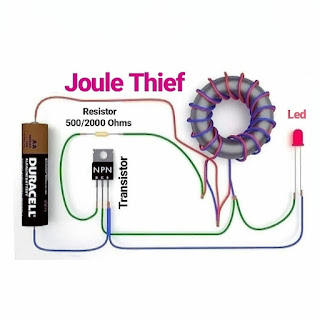Joule thief Projects and Circuits, How Joule Thief working principles, Circuit diagram, Application, Electronic Engineer projects
A "Joule Thief" is a basic voltage booster circuit. It can expand the voltage of a power source by changing the consistent low voltage signal into a progression of quick beats at a higher voltage. You most regularly observe this sort of circuit used to power LEDs with a "dead" battery, however there are a lot progressively potential applications for a circuit this way.A joule thief is a moderate self-oscillating voltage booster that is little, ease, and simple to fabricate, commonly utilized for driving little stacks. This circuit is additionally known by different names such as blocking oscillator, joule ringer, vampire burn.
It can utilize almost the majority of the vitality in a solitary cell electric battery, even far beneath the voltage where different circuits consider the battery completely released (or "dead"); thus the name, which recommends the idea that the circuit is stealingenergy or "joules" from the source - the term is a pun on the well established articulation "gem thief".
The circuit is a variation of the blocking oscillator that structures an unregulated voltage help converter. The yield voltage is expanded to the detriment of higher current draw on the information, yet the incorporated (normal) current of the yield is brought down and brilliance of a radiance diminished.
In this task, I am demonstrating how you can utilize a Joule Thief to accuse batteries of low-voltage power sources. Since the Joule Thief can support the voltage of a sign, you can accuse a battery of a power source whose yield voltage is really lower than the battery itself. This gives you a chance to exploit low voltage power sources, for example, thermoelectric generators, little turbines, and individual solar cells.
How Does a Joule Thief Work?
Joule Thief Battery Charger: Bring Back the "Dead"
This circuit utilized in this venture is an altered "Joule Thief." A Joule Thief is a self-wavering voltage enhancer it can be able to boost the voltage. It takes a consistent low voltage sign and changes over it into a progression of high recurrence beats at a higher voltage. Here is the means by which an essential Joule Thief works, well ordered:
1. At first the transistor is off.
2. A modest quantity of power experiences the resistor and the principal loop to the base of the transistor. This incompletely opens up the gatherer producer channel. Power is currently ready to go during that time curl and through the gatherer producer channel of the transistor.
3. The expanding measure of power during that time curl produces an attractive field that initiates a more prominent measure of power in the main loop.
4. The instigated power in the principal curl goes into the base of the transistor and opens up the authority producer channel significantly more. This lets much greater power travel during that time loop and through the authority producer channel of the transistor.
5. Stages 3 and 4 rehash in an input circle until the base of the transistor is immersed and the gatherer producer channel is completely open. The power going during that time loop and through the transistor are currently at a most extreme. There is a ton of vitality developed in the attractive field of the subsequent curl.
6. Since the power in the subsequent curl is never again expanding, it quits instigating power in the primary loop. This makes less power go into the base of the transistor.
7. With less power going into the base of the transistor, the gatherer producer channel starts to close. This enables less power to go during that time loop.
8. A drop in the measure of power in the subsequent curl initiates a negative measure of power in the main loop. This causes even less power to go into the base of the transistor.
9. Stages 7 and 8 rehash in a criticism circle until there is no power experiencing the transistor.
10. Some portion of the vitality that was put away in the attractive field of the subsequent curl has depleted out. Anyway there is still a great deal of vitality put away. This vitality needs to go some place. This causes the voltage at the yield of the loop to spike.
11. The developed power can't experience the transistor, so it needs to experience the heap (typically a LED). The voltage at the yield of the loop develops until it arrives at a voltage where is can experience the heap and be scattered.
12. The developed vitality experiences the heap in a major spike. When the vitality is scattered, the circuit is viably reset and begins the entire procedure once more. In an ordinary Joule Thief circuit this procedure happens 50,000 times each second.










